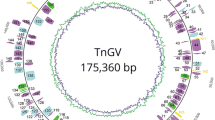Abstract
MSU-TnT4 (TnT4) cells, a newly established Trichoplusia ni cell line, was examined for the presence of a latent nodavirus, as had been described for another T. ni cell line, BTI-TN-5B1-4 (Hi5) cells. Reverse transcriptase polymerase chain reaction using nodavirus-specific primers did not detect virus genomic RNA in TnT4 cells. Transmission electron microscopy of recombinant baculovirus-infected TnT4 cells showed no evidence of latent nodavirus activation. Nodavirus particles were not detected in density gradients of baculovirus-infected TnT4 cell lysates or cell supernatants. The same methods confirmed the presence of a latent nodavirus in Hi5 cells.



Similar content being viewed by others
References
Adang M. J.; Miller L. K. Molecular-cloning of DNA complementary to messenger-RNA of the baculovirus Autographa-californica nuclear polyhedrosis-virus—location and gene-products of RNA transcripts found late in infection. J. Virol. 44: 782–793; 1982.
Ball L. A.; Johnson K. L. Nodaviruses of insects. In: Miller L. K.; Ball L. A. (eds) The insect viruses. Plenum Press, New York, pp 225–267; 1998.
Clem R. J.; Fechheimer M.; Miller L. K. Prevention of apoptosis by a baculovirus gene during infection of insect cells. Science 254: 1388–1390; 1991.
Clem R. J.; Miller L. K. Apoptosis reduces both the invitro replication and the invivo infectivity of a baculovirus. J. Virol. 67: 3730–3738; 1993.
Friesen P.; Scotti P.; Longworth J.; Rueckert R. Black beetle virus—propagation in Drosophila line-1 cells and an infection-resistant subline carrying endogenous Black beetle virus-related particles. J. Virol. 35: 741–747; 1980.
Garzon S.; Strykowski H.; Charpentier G. Implication of mitochondria in the replication of Nodamura virus in larvae of the Lepidoptera, Galleria-mellonella (L.) and in suckling mice. Arch. Virol. 113: 165–176; 1990.
Garzon S.; Charpentier G. Nodaviridae. In: Adams J. R.; Bonami J. R. (eds) Atlas of invertebrate viruses. CRC Press, Inc., Boca Raton, pp 351–370; 1991.
Granados R. R.; Li G. X.; Derksen A. C. G.; McKenna K. A. A new insect-cell line from Trichoplusia ni (Bti-Tn-5b1–4) susceptible to Trichoplusia ni single enveloped nuclear polyhedrosis-virus. J. Invertebr. Pathol. 64: 260–266; 1994.
Hershberger P. A.; Dickson J. A.; Friesen P. D. Site-specific mutagenesis of the 35-kilodalton protein gene encoded by Autographa-californica nuclear polyhedrosis-virus—cell line-specific effects on virus-replication. J. Virol. 66: 5525–5533; 1992.
Hink W. F. Established insect cell line from cabbage looper, Trichoplusia ni. Nature 226: 466–467; 1970.
International Committee on Taxonomy of Viruses, Virus Taxonomy 2008, http://www.ictvonline.org/virusTaxonomy.asp?version=2008, Cited 24 July 2009
Jarvis D. L. Baculovirus expression vectors. In: Miller L. K. (ed) The viruses. Plenum Press, New York, pp 389–431; 1997.
Kopek B. G.; Perkins G.; Miller D. J.; Ellisman M. H.; Ahlquist P. Three-dimensional analysis of a viral RNA replication complex reveals a virus-induced mini-organelle. PLoS. Biol. 5: 2022–2034; 2007.
Lanman J.; Crum J.; Deerinck T. J.; Gaietta G. M.; Schneemann A.; Sosinsky G. E.; Ellisman M. H.; Johnson J. E. Visualizing flock house virus infection in Drosophila cells with correlated fluorescence and electron microscopy. J. Struct. Biol. 161: 439–446; 2008.
Li T. C.; Scotti P. D.; Miyamura T.; Takeda N. Latent infection of a new Alphanodavirus in an insect cell line. J. Virol. 81: 10890–10896; 2007.
McKenna K. A.; Hong H. Z.; vanNunen E.; Granados R. R. Establishment of new Trichoplusia ni cell lines in serum-free medium for baculovirus and recombinant protein production. J. Invertebr. Pathol. 71: 82–90; 1998.
Miller L. K. The baculoviruses. Plenum Press, New York; 1997.
Miller D. J.; Schwartz M. D.; Ahlquist P. Flock house virus RNA replicates on outer mitochondrial membranes in Drosophila cells. J. Virol. 75: 11664–11676; 2001.
Miller D. J.; Ahlquist P. Flock-house virus RNA polymerase is a transmembrane protein with amino-terminal sequences sufficient for mitochondrial localization and membrane insertion. J. Virol. 76: 9856–9867; 2002.
Noad R.; Roy P. Virus-like particles as immunogens. Trends Microbiol. 11: 438–444; 2003.
O’Reilly D. R.; Miller L. K.; Luckow V. Baculovirus expression vectors: a laboratory manual. W. H. Freeman and Company, New York; 1992.
Prasad M. D.; Han S. J.; Nagaraju J.; Lee W. J.; Brey P. T. Cloning and characterization of an eukaryotic initiation factor-2 alpha kinase from the silkworm, Bombyx mori. Biochim. Biophys. Acta-Gene Struct. Expression. 1628: 56–63; 2003.
Scherer W. F.; Hurlbut H. S. Nodamura virus from Japan - a new and unusual arbovirus resistant to diethyl ether and chloroform. Am. J. Epidemiol. 86: 271–285; 1967.
Scherer W. F.; Verna J. E.; Richter G. W. Nodamura virus, an ether- and chloroform-resistant arbovirus from Japan—physical and biological properties with ecologic observations. Am. J. Trop. Med. Hyg. 17: 120–128; 1968.
Scotti P. D.; Dearing S.; Mossop D. W. Flock house virus—a nodavirus isolated from Costelytra zealandica (White) (Coleoptera, Scarabaeidae). Arch. Virol. 75: 181–189; 1983.
Settles E. W.; Friesen P. D. Flock house virus induces apoptosis by depletion of Drosophila inhibitor-of-apoptosis protein DIAP1. J. Virol. 82: 1378–1388; 2008.
Smith G. E.; Vlak J. M.; Summers M. D. Physical analysis of Autographa-californica nuclear polyhedrosis-virus transcripts for polyhedrin and 10,000- molecular-weight protein. J. Virol. 45: 215–225; 1983.
van Wynsberghe P. A.; Chen H. R.; Ahlquist P. Nodavirus RNA replication protein a induces membrane association of genomic RNA. J. Virol. 81: 4633–4644; 2007.
Vaughn J. L.; Goodwin R. H.; Tompkins G. J.; McCawley P. Establishment of 2 cell lines from insect Spodoptera frugiperda (Lepidoptera-Noctuidae). In Vitro-J. Tissue Culture Assoc 13: 213–217; 1977.
Zhang F.; Manzan M. A.; Peplinski H. M.; Thiem S. M. A new Trichoplusia ni cell line for membrane protein expression using a baculovirus expression vector system. In Vitro Cell. Dev. Biol.-Anim. 44: 214–223; 2008.
Acknowledgments
This work was supported in part by MSU grant TEC2008-0034. We thank Dr. Alicia Pastor for assistance with the electron microscopy.
Author information
Authors and Affiliations
Corresponding author
Additional information
Editor: J. Denry Sato
Rights and permissions
About this article
Cite this article
Zhang, F., Thiem, S.M. The Trichoplusia ni cell line MSU-TnT4 does not harbor a latent nodavirus. In Vitro Cell.Dev.Biol.-Animal 46, 1–6 (2010). https://doi.org/10.1007/s11626-009-9241-2
Received:
Accepted:
Published:
Issue Date:
DOI: https://doi.org/10.1007/s11626-009-9241-2




